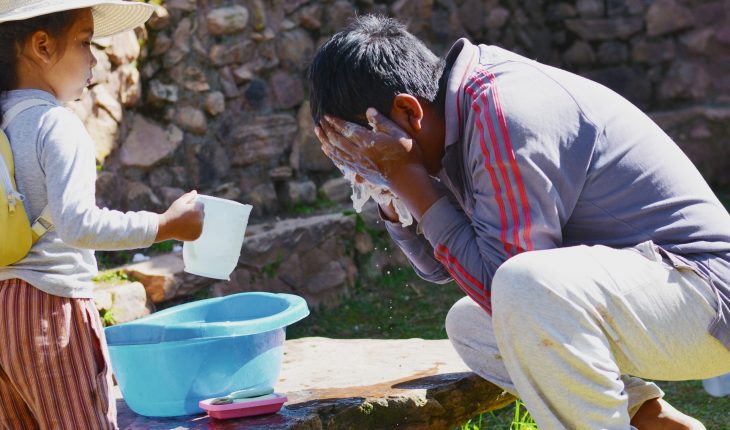Surely it has happened to you that you are bathing and suddenly you run out of water. Who do you blame when that happens? To the lack of this element aggravated by climate change? The government and its public policies? The indiscriminate use of this resource by consumers? Or the agencies in charge of managing and bringing this element to your home?
In reality, the problem of water supply in Mexico and the world, which makes you run out of water, is very complex and has many points of view, because it is a shared responsibility: an increasingly scarce resource, an inefficient use and an administration by governments that may be more appropriate.
Both in Mexico and in the world, water is an increasingly scarce or lower quality resource, and when the level at which demand is higher than the available quantity is reached, it is defined as water stress.
Photo: Cuartoscuro
Acueduqt is a global body that works with companies, governments and research partners to promote best practices in water resources management, and in August 2019 released its “Water Stress Atlas” in which it analyses this situation in 198 countries.
There are 17 countries with extremely high water stress, Qatar ranks first followed by Israel, Lebanon, Iran and Jordan, although there are also some of the most populous such as India and Pakistan. In these countries for an average year, agriculture, industry and municipalities consume 80% of the available surface and groundwater.
The second category, made up of 27 countries, are countries with high water stress. Mexico is among them, it is located in the 24th position of the global ranking and together with Chile, which is in the 18th place, they are the only two nations of the American continent with this situation.
When analyzing the case of Mexico, we discovered that the extension and diversity of the territory generate a diverse scenario, since there are areas with serious water problems and others where the amount of the available resource is more than enough.
“Mexico has land that is deserted and therefore there is a shortage of water naturally and there are parts of the country where we have a greater abundance of water. So there is an issue of natural water supply that is very variable throughout the country, and we have to admit that it is in profound change and that we can expect that with the climate issue it will change more and more, “explains Adriana Lobo, Executive Director of the World Resources Institute (WRI) Mexico.
According to the Water Atlas 2018 prepared by the National Water Commission (Conagua), the region with the greatest water stress is the Metropolitan Area of the Valley of Mexico, where there is an availability per inhabitant of 144 cubic meters of water per year.
Photo: Cuartoscuro
On the other hand, practically the entire north of the country reports a high level of water stress, to give an example, in the region that covers the metropolitan areas of Monterrey, Reynosa, Ciudad Juárez and Chihuahua, there is a record of 1,019 cubic meters of water per year per inhabitant in contrast to the region of Tabasco and Chiapas, where this indicator reaches 18,776 cubic meters per inhabitant per year.
At the national level, the average water per capita is 3,656 cubic meters per inhabitant per year.
“Two-thirds of the country is considered arid or semi-arid with low rainfall. 70% of the population lives in cities, which implies greater demands for water and the center-north of the country, where 32% of water is available and 77% of the population lives, is where there are greatest challenges of access to water. While the south-southeast has a smaller population, approximately 23%, and there is the largest amount of water: 68 percent, “summarizes Eduardo Vázquez, Executive Director of Agua Capital.
This situation is aggravated by two factors: every year the population increases and the available water decreases.
“Maybe in about 10 or 15 years we will have 10% less water that we have now available for everyone,” adds Aldo Ramírez, a professor at the Water Center of the School of Engineering and Sciences of Tec de Monterrey.
USERS
According to Conagua statistics, in 2017 (the date of the most recent report published), 87,842 million cubic meters of water were allocated for agricultural use, public supply, for the self-sufficient industry and thermoelectric plants.
Agricultural activity receives the most water: 76% (equivalent to 66,799 million cubic meters); in second place is the public supply, with 14.4% (12,628 million cubic meters); for integrated industrial use, 4.9% (4,267 million) is allocated, and for thermoelectric plants, 4.7% (4,147 million).nes).
And although agricultural activities consume more water worldwide, our country is a little above the global average, which is 70 percent.
Photo: Adobe Stock
Although there are important differences in these indicators, for example, in India 90% of the annual freshwater extraction is for agricultural use; 2.2%, industrial, and 7.4% for public supply; in Indonesia the percentages are divided into 81.9% agricultural, 6.5% industrial and 11.6% public supply.
In contrast, Russia allocates 19.9% for agricultural use, 59.8% for industrial use and 20.2% for public supply; and in France the distribution is 10.4% agricultural, 71.5% industrial and 18.1% for public supply, according to World Bank data.
However, this proportion of agricultural water use in Mexico is not necessarily a negative situation.
“The use of water as the main source for agriculture is something that is repeated globally, that is, agriculture is really a very water-intensive activity, and we all agree that it is okay to use water so that we can eat,” says Lobo.
However, these figures reflect who are the main consumers of this resource, and show that contrary to what is often claimed, it is an activity that consumes a lower percentage of the water available in the country.
“In the case of the industry, we are not a relevant player in volumetric issues. Yes, we are a visible player,” says Carlos Hurtado, Sustainable Development Manager at FEMSA Foundation.
This does not mean that any of these consumers (agriculture, domestic consumption, thermoelectric and industry) undertake actions and develop strategies to make more efficient use of this resource.
“The truth is that the biggest areas of opportunity are in agricultural use. That’s where we use water the most inefficiently. And if the irrigation systems are still the old, conventional ones, a lot of water is lost, it is not really given a productive use. Sometimes it becomes a little easy to find a possible culprit, and if we see a large industry that maybe is using significant volumes of water immediately many people turn to say ‘it’s the fault of the industry’, but the numbers do not give that, “recognizes the professor of tec de Monterrey.
In this area, the country also faces serious contrasts, as there are entities such as Sinaloa and Colima that allocate more than 90% of the water concessioned to agricultural activity; while Quintana Roo and Guerrero, less than 30%, and Mexico City only 0.1%, as 97.1% goes to public supply.
On the other hand, for the self-supplied industry, Quintana Roo reports that it uses 53% of the concessioned liquid, while Veracruz and Puebla between 15 and 20%, in contrast to Guerrero and Sinaloa: 0.5%.
Photo: Cuartoscuro
“In the case of cities and the countryside, the trend is very clear and the numbers reflect great inefficiencies and waste. The agricultural sector has several elements that are relevant to put on the table: they do not pay for the use of water and not only that, but they have subsidies for electricity to pump it, with which they obviously have a misaligned incentive to use it in a better way, “says Vázquez.
Knowing this situation can help to understand a little better the problem of water supply and find possible solutions.
“One of the most important issues we have to do as a society is to recognize that the issue of water is everyone’s issue and we all have to work on it. We have the Water Funds platform that is a platform for collective action to bring different members of society to create a common vision of what we want or what our relationship with water should be based on science,” adds Hurtado.
Photo: Special
THE ALTERNATIVES
Extracting water from aquifers or generating large infrastructure works, such as the Cutzamala system, responsible for around 30% of the water supply in the Metropolitan Area of the Valley of Mexico, have been the most common alternatives to bring water to the country’s cities.
However, it is necessary to promote other types of initiatives and develop solutions based on science and nature to address the growing gap if action is not taken.
“Bringing water from other basins, from other states, implies conflicts that we see in Cutzamala, conflicts that we see in the El Zapotillo Dam, conflicts that we see in Sonora, with the Independencia Aqueduct, conflicts that once also occurred between Nuevo León and Tamaulipas. In that sense, we should think more about those more natural solutions,” argues Ramírez.
Such initiatives require not only the participation of governments, but of academia, civil society, citizenship and industry.
“We think the soNature-based solutions are longer-term, but in general they are more in-depth solutions, more durable, and that solve more problems at the same time, much more complex problems in their context. Nature-based solutions in general have a fairly broad number of benefits,” says Lobo.
This type of solution seeks, among other effects, to maintain the recharge areas of the aquifers so that the water infiltrates properly; also implement solutions such as the use of rainwater or reuse systems, promote bioretention lagoons and wetlands, among other alternatives.
Many of these alternatives have been developed and seen the light thanks to the so-called Water Funds, collaboration platforms of various actors, mostly made up of the private sector, which promote a series of actions and approaches to action based on nature to promote water security in different cities of the country.
Photo: Cuartoscuro
There are currently at least 26 such instruments throughout Latin America, which form the Latin American Alliance of Water Funds, a cooperation and collaboration structure implemented and promoted by the FEMSA Foundation, the Inter-American Development Bank, The Nature Conservation, the Global Environment and Environment Fund of Germany.
“Water Funds for us have several components that make them not only successful, but we believe they can be a cornerstone for this new way of doing this collective action. The first is: we sit people at the table to share a vision; we are more likely to come up with a shared solution if everyone shares the view of the problem and understands it equally. And in order to have that understanding, it is very important to base ourselves on science,” explains Hurtado.
Once that is done, each actor that participates in these funds contributes to the solution, according to their strengths, as well, for example: the Private Initiative summons the actors and pushes innovative solutions, the academy contributes the studies and knowledge, the governments create the public policies and allocate the budgets to implement them, and civil society monitors and summons citizens to be part of the solutions.
Photo: Special
THE ACTIONS
Although the industry consumes less than 5 out of every 100 liters of concessioned water in the country, IP in general and many companies in particular have taken their responsibility to take care of this resource very seriously.
“Undoubtedly, the industry has taken an important role in promoting innovative initiatives not only in the field of Water Funds, but also in technological investments. And it makes sense, because the main incentive that the industry has is that if they are not efficient in the use of water, they will hardly be efficient in the management of their operations and their businesses. So there is a very clear incentive and therefore they do invest many resources aimed at promoting water balance, “says Vázquez.
An example of this is the case of Coca-Cola FEMSA, which is committed to enshing that the water used for production is properly treated and returned with quality higher than what is required by the environmental standard. Additionally, the water used for the manufacture of beverages is also returned to nature.
Photo: Cuartoscuro
“How do we return it? We do it in several ways: the first is to return water to the environment or to communities through efforts, such as reforestation and conservation work, and this is because when you reforest an area what you are doing is like rehabilitating the natural sponge that we have there, then when it rains the water instead of running and leaving, it stops and infiltrates our mantles, so the equivalent of that water is returning,” explains the manager of femsa Foundation.
Also, he adds, projects are developed in communities that do not have water and wells or rainwater harvesting structures are installed.
These actions are based on internationally accepted methodologies that define how much a tree infiltrates, a conserved area, or how much water is captured by the installed infrastructure.
Another example is palpable in San Cristóbal de las Casas, in the area of the Altos de Chiapas, one of those with the highest availability of water in Mexico, since figures from Conagua indicate that it has an average annual availability volume of 33,908 million cubic meters. There is the plant with the greatest efficiency in the use of water of Coca-Cola FEMSA, since it registers an average of 1.17 liters of water per liter of beverage produced.
This plant has a Clean Industry level 2 certificate from the Federal Attorney for Environmental Protection (Profepa) while its Wastewater Treatment Plant is the only one andn operation in the area of San Cristóbal.
In addition, since 2008 it has promoted the planting of more than 150,000 trees, as well as the installation of 19 community cisterns, 38 water harvesting roofs, 45 backyard orchards, 35 wood-saving stoves and 15 fruit orchards.
THE FUTURE
In terms of water supply, the price of doing nothing will be, in the medium and long term, much higher than that of taking the necessary actions to avoid a crisis of important dimensions.
Promoting the efficient use of the resource in all sectors, protecting and expanding aquifer recharge zones, maintaining and creating more infrastructure, encouraging rainwater harvesting and the installation of water treatment plants are some of the alternatives that have to be taken to avoid scenarios of large shortages.
Photo: Cuartoscuro
“There are things to do along the way, cultural issues of reuse, technical issues, but we have to move forward on that path: the question of rainwater, but the truth, we have few cases in which we could say ‘ah, look, in this city we are working on rainwater harvesting as an additional resource’. Also like we could walk a little more out there,” says the Tec professor.
Changes in rainfall patterns generated by climate change pose a scenario of greater uncertainty and scarcity.
“Maybe in a year the same amount of water falls in a region, but instead of falling in three months it falls in one. So that generates flooding problems, but in addition there is only a certain capacity to have the water stored and then the rest goes; and the periods of drought are becoming more and more intense and bigger,” says Hurtado.
That is why the coordination and cooperation of all sectors is necessary to find the greatest number of viable solutions.
“In the case of the Valley of Mexico there are recent studies by academic institutions such as UNAM, organizations such as the World Bank, which estimate that, at any given time, if we continue in this scheme, tendentially to 50 or 60 years, the aquifers of the Valley could be compromised in terms of their useful life and I am sure that this is the same phenomenon that we have in Monterrey, in Guadalajara and other urban centers.
“This shows the need to make substantive decisions, shows the need to invest greater resources, shows the need to be more efficient, technological innovation, to promote new management models, to take care of ecosystems, to better prepare for the effects of climate change, to have a solid financial system for the water sector and to generate the appropriate incentives for all sectors and citizens to work from jointly,” adds the Director of Agua Capital.
Photo: Special
And there are scenarios where the impact of climatic phenomena can be very severe in our country, since it is estimated that around 68% of the population and 71% of GDP would be exposed to the negative effects of climate change. To cite an example, you could have a reduction in harvests between 5 and 20% of the current situation; although if the situation worsens, reductions between 40 and 70% in food production are expected.
“Losses of that magnitude are extremely severe and are completely linked to the water cycle. So, not to be attentive in the creation of solutions is to expose ourselves to crises of magnitudes that we do not want to be exposed. We have to take action, be attentive, active, doing longer-term planning, because here it is useless for us to rescue the harvest of a year if we know that these phenomena have very long-term applications, “concludes Lobo.





